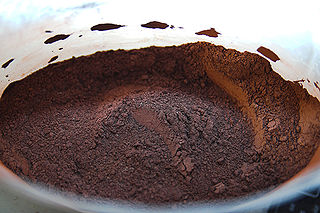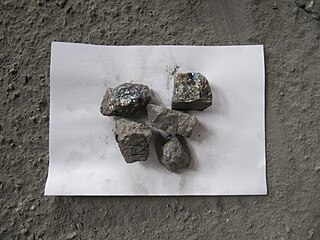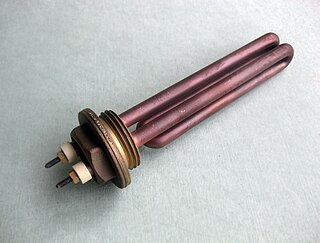Related Research Articles

Aluminium is a chemical element; it has symbol Al and atomic number 13. Aluminium has a density lower than that of other common metals, about one-third that of steel. It has a great affinity towards oxygen, forming a protective layer of oxide on the surface when exposed to air. Aluminium visually resembles silver, both in its color and in its great ability to reflect light. It is soft, nonmagnetic, and ductile. It has one stable isotope, 27Al, which is highly abundant, making aluminium the twelfth-most common element in the universe. The radioactivity of 26Al, a more unstable isotope, leads to it being used in radiometric dating.

Stainless steel, also known as inox, corrosion-resistant steel (CRES) and rustless steel, is an alloy of iron that is resistant to rusting and corrosion. It contains at least 10.5% chromium and usually nickel, as well as 0.2 to 2.11% carbon. Stainless steel's resistance to corrosion results from the chromium, which forms a passive film that can protect the material and self-heal in the presence of oxygen.

Thermite is a pyrotechnic composition of metal powder and metal oxide. When ignited by heat or chemical reaction, thermite undergoes an exothermic reduction-oxidation (redox) reaction. Most varieties are not explosive, but can create brief bursts of heat and high temperature in a small area. Its form of action is similar to that of other fuel-oxidizer mixtures, such as black powder.
In physical chemistry and engineering, passivation is coating a material so that it becomes "passive", that is, less readily affected or corroded by the environment. Passivation involves creation of an outer layer of shield material that is applied as a microcoating, created by chemical reaction with the base material, or allowed to build by spontaneous oxidation in the air. As a technique, passivation is the use of a light coat of a protective material, such as metal oxide, to create a shield against corrosion. Passivation of silicon is used during fabrication of microelectronic devices. Undesired passivation of electrodes, called "fouling", increases the circuit resistance so it interferes with some electrochemical applications such as electrocoagulation for wastewater treatment, amperometric chemical sensing, and electrochemical synthesis.

Brazing is a metal-joining process in which two or more metal items are joined by melting and flowing a filler metal into the joint, with the filler metal having a lower melting point than the adjoining metal.

Industrial processes are procedures involving chemical, physical, electrical, or mechanical steps to aid in the manufacturing of an item or items, usually carried out on a very large scale. Industrial processes are the key components of heavy industry.

Ferromanganese is an alloy of iron and manganese, with other elements such as silicon, carbon, sulfur, nitrogen and phosphorus. The primary use of ferromanganese is as a type of processed manganese source to add to different types of steel, such as stainless steel. Global production of low-carbon ferromanganese reached 1.5 megatons in 2010.

A heating element is a device used for conversion of electric energy into heat, consisting of a heating resistor and accessories. Heat is generated by the passage of electric current through a resistor through a process known as Joule Heating. Heating elements are used in household appliances, industrial equipment, and scientific instruments enabling them to perform tasks such as cooking, warming, or maintaining specific temperatures higher than the ambient.

Ferrochrome or ferrochromium (FeCr) is a type of ferroalloy, that is, an alloy of chromium and iron, generally containing 50 to 70% chromium by weight.
Ferroalloy refers to various alloys of iron with a high proportion of one or more other elements such as manganese (Mn), aluminium (Al), or silicon (Si). They are used in the production of steels and alloys. The alloys impart distinctive qualities to steel and cast iron or serve important functions during production and are, therefore, closely associated with the iron and steel industry, the leading consumer of ferroalloys. The leading producers of ferroalloys in 2014 were China, South Africa, India, Russia and Kazakhstan, which accounted for 84% of the world production. World production of ferroalloys was estimated as 52.8 million tonnes in 2015.

Ferrocerium is a synthetic pyrophoric alloy of mischmetal hardened by blending in oxides of iron and/or magnesium. When struck with a harder material, the mixture produces hot sparks that can reach temperatures of 3,315 °C (6,000 °F) when rapidly oxidized by the process of striking the rod. Striking both scrapes fragments off, exposing them to the oxygen in the air, and easily ignites them by friction heat due to cerium's remarkably low ignition temperature of between 150 and 180 °C.

Ferrovanadium (FeV) is an alloy formed by combining iron and vanadium with a vanadium content range of 35–85%. The production of this alloy results in a grayish silver crystalline solid that can be crushed into a powder called "ferrovanadium dust". Ferrovanadium is a universal hardener, strengthener and anti-corrosive additive for steels like high-strength low-alloy steel, tool steels, as well as other ferrous-based products. It has significant advantages over both iron and vanadium individually. Ferrovanadium is used as an additive to improve the qualities of ferrous alloys. One such use is to improve corrosion resistance to alkaline reagents as well as sulfuric and hydrochloric acids. It is also used to improve the tensile strength to weight ratio of the material. One application of such steels is in the chemical processing industry for high pressure high throughput fluid handling systems dealing with industrial scale sulfuric acid production. It is also commonly used for hand tools e.g. spanners (wrenches), screwdrivers, ratchets, etc.

Aluminothermic reactions are exothermic chemical reactions using aluminium as the reducing agent at high temperature. The process is industrially useful for production of alloys of iron. The most prominent example is the thermite reaction between iron oxides and aluminium to produce iron itself:
Ferrosilicon is an alloy of iron and silicon with a typical silicon content by weight of 15–90%. It contains a high proportion of iron silicides.
Aluminium carbide, chemical formula Al4C3, is a carbide of aluminium. It has the appearance of pale yellow to brown crystals. It is stable up to 1400 °C. It decomposes in water with the production of methane.

An aluminium alloy (UK/IUPAC) or aluminum alloy is an alloy in which aluminium (Al) is the predominant metal. The typical alloying elements are copper, magnesium, manganese, silicon, tin, nickel and zinc. There are two principal classifications, namely casting alloys and wrought alloys, both of which are further subdivided into the categories heat-treatable and non-heat-treatable. About 85% of aluminium is used for wrought products, for example rolled plate, foils and extrusions. Cast aluminium alloys yield cost-effective products due to the low melting point, although they generally have lower tensile strengths than wrought alloys. The most important cast aluminium alloy system is Al–Si, where the high levels of silicon (4–13%) contribute to give good casting characteristics. Aluminium alloys are widely used in engineering structures and components where light weight or corrosion resistance is required.
6061 aluminium alloy is a precipitation-hardened aluminium alloy, containing magnesium and silicon as its major alloying elements. Originally called "Alloy 61S", it was developed in 1935. It has good mechanical properties, exhibits good weldability, and is very commonly extruded. It is one of the most common alloys of aluminium for general-purpose use.

Exothermic welding, also known as exothermic bonding, thermite welding (TW), and thermit welding, is a welding process that employs molten metal to permanently join the conductors. The process employs an exothermic reaction of a thermite composition to heat the metal, and requires no external source of heat or current. The chemical reaction that produces the heat is an aluminothermic reaction between aluminium powder and a metal oxide.
Deoxidized steel is steel that has some or all of the oxygen removed from the melt during the steelmaking process. Liquid steels contain dissolved oxygen after their conversion from molten iron, but the solubility of oxygen in steel decreases with cooling. As steel cools, excess oxygen can cause blowholes or precipitate FeO. Therefore, several strategies have been developed for deoxidation. This may be accomplished by adding metallic deoxidizing agents to the melt either before or after it is tapped, or by vacuum treatment, in which carbon dissolved in the steel is the deoxidizer.
William John Arbegast, Jr. was an American metallurgical engineer, mechanical engineer and friction stir welding expert.
References
- 1 2 3 "Ferro Aluminium". Miller and Co. Retrieved October 20, 2018.
- ↑ "Ferro Aluminum (FeAl) Powder". Reade Advanced Materials. Retrieved October 20, 2018.
- ↑ "30% Ferro Aluminum". Belmont. Retrieved October 20, 2018.
- ↑ "ferroaluminum". Dictionary.com. Retrieved October 20, 2018.
- ↑ "ferroaluminum". Merriam-Webster Dictionary. Retrieved October 20, 2018.
- ↑ Meka, S.R.; Chauhan, A.; Steiner, T.; Bischoff, E.; Ghosh, P.K.; Mittemeijer, E.J. (2015). "Generating duplex microstructures by nitriding; nitriding of iron based Fe–Mn alloy". Materials Science and Technology: 1743284715Y.000. doi: 10.1179/1743284715Y.0000000098 .
- ↑ "Ferro Aluminum". Aria Ferroalloy Co. Retrieved October 20, 2018.
- ↑ De Vries, Ralph P.; De Fries, Henry A. (June 25, 1929). "Patent US1718685A - Ferro-aluminum alloy and method of making it". Google Patents. Retrieved October 20, 2018.
- 1 2 "Ferro Aluminium Description and Uses". Cometal. Retrieved October 20, 2018.
- ↑ "Ferro Aluminium". Westbrook Resources. Retrieved October 20, 2018.